Purple birds are some of the most eye-catching creatures in the wild. Their feathers shine in sunlight, showing off deep and rich purple shades. From the purple cardinal bird to the purple parakeet, these birds capture hearts with their unique look. Some are found in tropical forests, while others live in quiet backyards.
Many bird lovers search for purple birds because they are rare and stunning. Seeing a purple bird fly through the sky feels like spotting a living gem. Some have bright purple heads, while others have full purple bodies. These birds include different types like parrots, cardinals, and even doves. Whether you’re a bird watcher or just love nature, learning about purple birds is exciting and fun. Their colors, songs, and habits make them unforgettable. Keep reading to explore the most beautiful purple birds around the world and what makes each one so special.
Top 13 Purple Birds Species (A List With Information)
Purple birds are rare and beautiful, making them favorites among bird watchers and nature lovers. Their vibrant plumage stands out in forests, wetlands, and even gardens. From the tiny purple parakeet to the striking purple cardinal bird, each species offers something unique. These birds often live in tropical regions and are known for their bright feathers and melodic songs.
In this guide, you’ll explore the top 13 purple birds species (a list with information) to help you spot and enjoy these stunning creatures. Whether you’re a casual bird lover or a serious bird watcher, this list will introduce you to the world of purple birds and their colorful charm.
Bird 1: Purple Martin
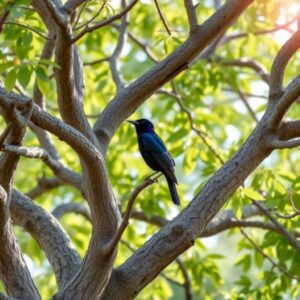
- Scientific name: Progne subis
- Lifespan: 5–7 years
- Wingspan: 11–13 inches
- Native to: North America
- Size: 7.5 to 8.5 inches in length
- Food or Diet: Flying insects and ants
The Purple Martin is one of the most loved songbirds in North America. Known for its glossy purple feathers, it looks stunning in sunlight.
This bird belongs to the swallow family and is famous for its graceful flight. People often place birdhouses to welcome them during nesting season.
Purple Martins are migratory birds. They travel to South America in winter and return to North America in spring to breed.
They eat flying insects like beetles, moths, and flies. This helps control pests in gardens and fields.
These birds prefer open spaces near water. They build nests in man-made structures like gourds or wooden houses.
With cheerful songs and active flight, the Purple Martin adds joy to the sky. Their friendly behavior and colorful plumage make them a favorite among bird watchers and nature lovers alike.
Bird 2: Purple Honeycreeper
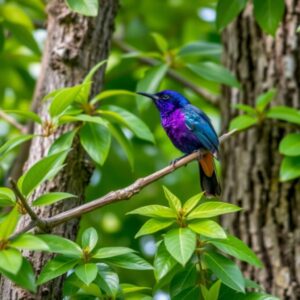
- Scientific name: Cyanerpes caeruleus
- Lifespan: Around 5–6 years
- Wingspan: 50.5-60.0 mm
- Native to: northern South America and Panama
- Size: 4.5 in (11.5 cm) long, weighs 0.42 oz (12 g)
- Food or Diet: Nectar, fruits, insects
The Purple Honeycreeper is a tiny bird with striking colors. Males shine in deep purple-blue with black wings and a slim, curved bill.
These birds love tropical places and are mostly found in the rainforests of South America. You’ll often spot them high up in the trees.
They feed mainly on nectar, but they also eat fruit and insects when they can. Their diet keeps them active and full of energy.
Their curved bill helps them reach deep into flowers, just like a hummingbird. It’s perfect for sipping sweet nectar.
Purple Honeycreepers are social and often seen in pairs or small groups. Their high-pitched calls are sharp and easy to recognize.
Though small, they stand out with their bright color and fast moves. Bird watchers always enjoy catching a glimpse of this tropical beauty.
Read More: 55 Excellent Replies to ‘How Was Your Night?’
Bird 3: Purple-breasted Cotinga
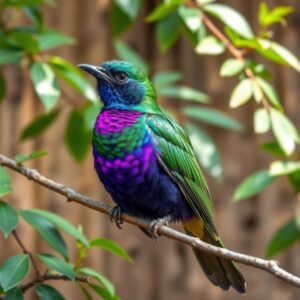
- Scientific name: Cotinga cotinga
- Lifespan: Around 5–8 years
- Wingspan: 107-112 mm for males and 102-108 mm
- Native to: South America
- Size: 18.0 to 20.5 centimeters (7.1 to 8.1 inches
- Food or Diet: Fruits and berries
The Purple-breasted Cotinga is one of the most eye-catching birds in the rainforest. Its bold colors make it look like a flying jewel.
This bird has deep purple on its chest and bright blue wings. The colors shine even more in sunlight, making it hard to miss.
It lives in the tropical forests of South America. You’ll mostly find it in the Amazon region, resting high in the canopy.
The bird’s diet includes fruits and berries. It plays a big part in spreading seeds around the forest.
The Purple-breasted Cotinga is quiet and often shy. Unlike some songbirds, it doesn’t sing much but is still easy to spot.
Bird watchers love this species for its rare beauty. Among all purple birds, this one truly stands out with its bright feathers and calm nature.
Bird 4: Varied Bunting
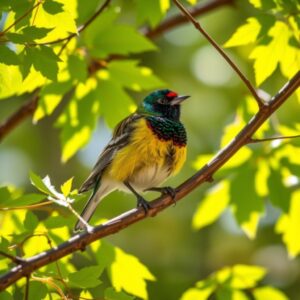
- Scientific name: Passerina versicolor
- Lifespan: up to 7 years
- Wingspan: 8.3 inches
- Native to: Mexico, Arizona, California
- Size: 4.3 to 5.5 inches (11 to 14 centimeters) in length
- Food or Diet: Seeds, insects, berries
The Varied Bunting is a small but striking bird with a mix of deep purple, red, and blue shades. Males look especially bright in the sunlight.
This colorful bird lives mostly in Mexico and parts of the southwestern United States. It likes dry brushy areas and desert canyons.
During the breeding season, the male sings softly to attract a mate. Its gentle song often comes from a hidden perch.
The Varied Bunting builds its nest low in shrubs using twigs and grasses. It prefers quiet spots for raising its young.
Its diet includes seeds, berries, and insects. This mix helps it stay strong and healthy in the wild.
Though shy, it’s a favorite among bird watchers. The Varied Bunting is a gem for anyone lucky enough to spot one in nature.
Bird 5: Purple Starling
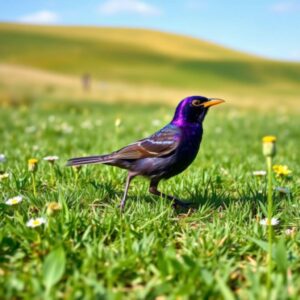
- Scientific name: Lamprotornis purpureus
- Lifespan: up to 20 years
- Wingspan: 31-40 cm (12.2-15.8 inches)
- Native to: Sub-Saharan Africa
- Size: 25-27cm
- Food or Diet: Insects and fruits
The Purple Starling is a striking bird with glossy purple and blue feathers. Its body shines like metal in the sunlight.
It belongs to the starling species and lives mostly in the tropical regions of Africa. You’ll often see it flying through open woodlands and savannas.
This bird has a short tail, bright yellow eyes, and strong legs. It’s bold and not shy around people.
Purple starlings are omnivorous birds. They eat fruits, seeds, and insects. They often feed in groups and make loud, chattering sounds.
During breeding season, they build nests in tree holes or abandoned nests. Both parents help raise the chicks.
Bird watchers love this species for its color and personality. It’s one of the most eye-catching birds of Africa and a favorite among bird lovers.
Bird 6: Violet Sabrewing
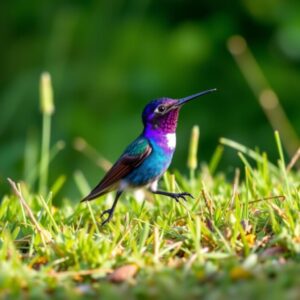
- Scientific name: Campylopterus hemileucurus
- Lifespan: 4 to 7 years
- Wingspan: 82.6 mm (3.25 inches)
- Native to: Mexico and Central America
- Size: 13 to 15 cm
- Food or Diet: Nectar and insects
The Violet Sabrewing is one of the largest hummingbirds. Its deep purple feathers shine like gems in the sunlight. Males are more vibrant than females.
You’ll mostly see this bird in Central America. It loves the forests of Costa Rica, Honduras, and Nicaragua. It usually stays near flowers.
This bird feeds on nectar. It uses its long bill to sip sweet juices from bright tropical flowers. It also eats small insects for protein.
The name “sabrewing” comes from its thick, curved wings. These strong wings help it hover and move quickly from flower to flower.
It prefers shady forest edges and gardens. You might spot one near mountain areas with lots of blooms.
Bird watchers admire the Violet Sabrewing for its beauty and speed. It’s a true treasure among purple birds, adding color and charm to the wild.
Bird 7: Violet-backed Starling

- Scientific name: Cinnyricinclus leucogaster
- Lifespan: Around 5 years
- Wingspan: 9 to 10 inches
- Native to: Sub-Saharan Africa
- Size: 18 centimeters (7 inches)
- Food or Diet: Insects and fruits
The Violet-backed Starling is a small but striking bird. It shines with deep purple feathers that look metallic in the sun.
Males have bright violet backs and pure white bellies. Females look very different, with brown streaks and a softer pattern.
This beautiful bird belongs to the starling species. It’s one of the most colorful birds in the woodlands of Sub-Saharan Africa.
They live in open forests and savannas, often seen flying in pairs or small groups. These forest birds enjoy warm climates.
Their diet includes insects, berries, and fruits. They’re known as omnivorous birds and often feed high in the trees.
During breeding season, they nest in tree holes. The female lays eggs and handles most of the care while the male protects their space.
Bird 8: Blacked-Capped Kingfisher
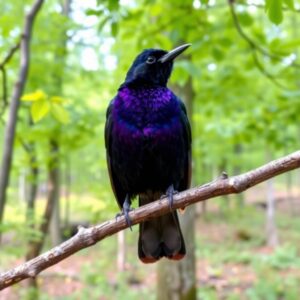
- Scientific name: Halcyon pileata
- Lifespan: Around 10 years
- Wingspan: Not found
- Native to: Asia and Southeast Asia
- Size: 28cm-11inch
- Food or Diet: Fish, insects, small crabs
The Black-capped Kingfisher is a striking bird with bold colors. Its deep black cap contrasts beautifully with its bright blue wings and back.
This bird belongs to the tree kingfishers, known for their strong bills and vibrant feathers. It often sits still before diving for prey.
Native to parts of Asia, especially coastal and forested regions, this kingfisher prefers wetlands, riversides, and mangroves.
Its diet includes insects, fish, frogs, and small crabs. It hunts by watching quietly, then swiftly catching its target.
With a wingspan of around 11 inches, it shows powerful flight, often flying low over water during hunting.
During breeding season, they nest in riverbanks or termite mounds. The male performs calls and flights to attract a mate. The Black-capped Kingfisher is a favorite among bird watchers due to its beauty and lively behavior.
Bird 9: American Purple Gallinule
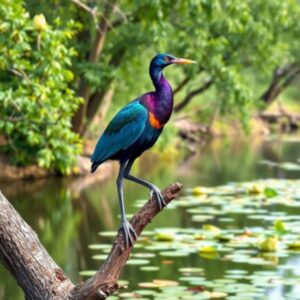
- Scientific name: Porphyrio martinicus
- Lifespan: 22 years
- Wingspan: 21 inches
- Native to: Americas and Caribbean
- Size: About 13 inches
- Food or Diet: Insects, plants, seeds, small fish, spiders
The American Purple Gallinule is a stunning tropical bird with bright colors and a unique look. It has purple-blue feathers, a red bill, and yellow legs.
This bird is often found in marshes and wetlands, walking across lily pads with ease. It belongs to the rail family and stands out among other wetland birds.
Its bird diet includes insects, seeds, snails, and small fish. It’s known as an omnivorous bird with excellent foraging skills.
The breeding season runs from spring to summer. Nests are made in thick vegetation near water.
Both parents take part in avian incubation and feeding. They are also territorial birds during nesting time.
The American Purple Gallinule is a favorite among bird watchers and bird enthusiasts for its bold colors and fascinating bird behavior.
Bird 10: Costa’s Hummingbird
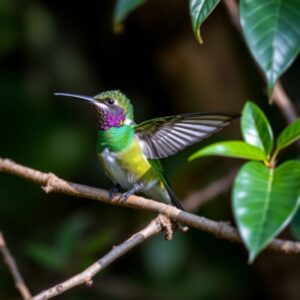
- Scientific name: Calypte costae
- Lifespan: 5 to 6 years
- Wingspan: 11cm–4 inches
- Native to: Mexico, United States
- Size: 3–3.5 inches
- Food or Diet: Nectar, small insects, flowers
The Costa’s Hummingbird is a small, vibrant bird with striking violet feathers. Males have a bold purple crown and throat that shine in sunlight. Females are more muted but still charming.
These tiny birds are found mostly in the deserts of the southwestern United States and Baja California. They love warm, dry climates.
They feed on nectar from desert flowers. They also catch small insects for protein.
Their wings beat rapidly, allowing them to hover in place. This helps them feed with great precision.
During mating season, males perform looped dives and sing to impress females. It’s a graceful show.
Though small in size, the Costa’s Hummingbird brings life and color to desert landscapes with its brilliant display.
Bird 11: Crowned Woodnymph
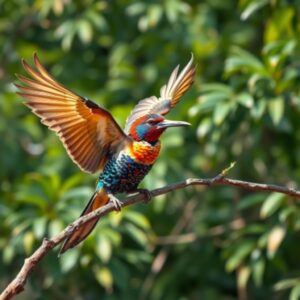
- Scientific name: Thalurania colombica
- Lifespan: Around 5–9 years
- Wingspan: About 4 inches
- Native to: Belize and Guatemala to northern Peru
- Size: 9.5 to 11.5 cm (3 to 4 inches)
- Food or Diet: Nectar and small insects
The Crowned Woodnymph is a small, vibrant hummingbird known for its glowing feathers. Males show off brilliant green and deep purple colors. Females are more muted with green upperparts and grayish underparts.
This bird belongs to the hummingbird family and is loved for its shimmering beauty. You’ll often see it flitting from flower to flower.
It lives in tropical regions, especially lowland forests and gardens in Central and South America.
Its diet includes nectar from flowers and small insects. The long beak helps reach deep into blooms.
During the breeding season, females build small cup-shaped nests using spiderweb nest material and soft plant fibers.
The Crowned Woodnymph is a favorite among bird watchers and bird enthusiasts for its bold colors and quick, darting flight.
Bird 12: Lilac-Breasted Roller
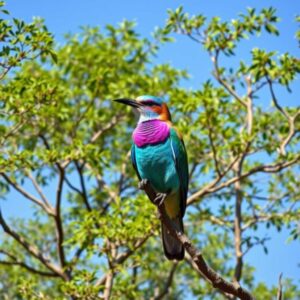
- Scientific name: Coracias caudatus
- Lifespan: Around 10 years
- Wingspan: 50 to 58 cm (19.7 to 22.8 inches)
- Native to: Sub-Saharan Africa
- Size: 36-38 cm (14.2-15 inches)
- Food or Diet: Insects and small reptiles snails and small birds
The Lilac-Breasted Roller is one of Africa’s most colorful birds. Its feathers shine with lilac, blue, green, and turquoise tones.
This bird belongs to the roller family birds and is admired for its bright appearance.
It lives in open woodlands and native ecosystems across Sub-Saharan Africa. You’ll often spot it perched alone on trees or wires.
The bird diet includes insects, spiders, and small lizards. It catches food from the ground with sharp dives.
During the breeding season, it nests in tree holes. Both parents care for the chicks during avian incubation.
Known for its bold flight and territorial bird behavior, the Lilac-Breasted Roller is a true icon of African bird species.
Bird 13: Purple-Crowned Fairywren
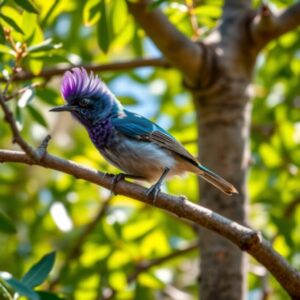
- Scientific name: Malurus coronatus
- Lifespan: Up to 17 years
- Wingspan: 16cm (6.3inches)
- Native to: Northern Australia
- Size: 14cm (5.5 inches)
- Food or Diet: Insects and spiders little seeds
The Purple-Crowned Fairywren is a small, colorful bird found in northern Australia. It’s best known for the male’s striking purple crown.
This bird belongs to the Fairywren species, part of the songbird group. Males display brighter colors during the breeding season to attract mates.
They live in dense shrubs near wetlands or along rivers. These bird habitats provide safety and food.
Their diet includes small insects, making them skilled insect-eating birds. They forage low in the bushes.
Purple-Crowned Fairywrens are monogamous birds and often stay in small family groups.
Though tiny in size, their vibrant feathers and busy nature make them favorites among bird watchers and bird enthusiasts.
FAQ’S
What makes these birds look so bright?
Purple birds get their color from light reflecting off special feather structures. This makes purple birds shine more than just using pigments.
Where can I spot them?
You can find purple birds in rainforests, wetlands, and open fields. Some purple birds also visit backyard feeders in certain seasons.
Are they common or rare?
Some purple birds are rare and found only in tropical areas. Others are more common and seen across regions where purple birds naturally thrive.
Do they all sing?
Not all sing, but many purple birds make beautiful sounds. These vocal tones help purple birds attract mates and protect their space.
What do they eat?
Many purple birds eat insects, nectar, or fruits. The diet of purple birds depends on their species and natural habitat.
Conclusion
Purple birds are truly a gift from nature. Their bright feathers, sweet songs, and unique habits make them stand out. From the tiny purple parakeet to the stunning purple cardinal bird, each has something special. These birds are not only beautiful but also play a big role in their ecosystems. Some help control insects, while others spread seeds or pollinate flowers. Watching a purple bird fly through the trees is a moment many bird lovers dream of.
Bird watchers and nature fans enjoy learning about these colorful creatures. Whether it’s the playful purple parakeet or the shy purple-crowned fairywren, there’s always something new to discover. With their striking looks and interesting behaviors, purple birds bring joy and wonder. Their presence reminds us how magical the world of birds can be. Let’s protect their homes and keep their songs alive for future generations to enjoy. Nature needs these beauties to thrive.


m6qj7c